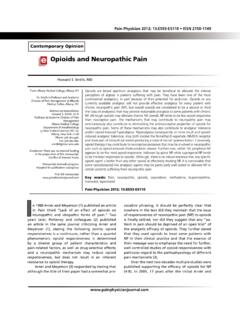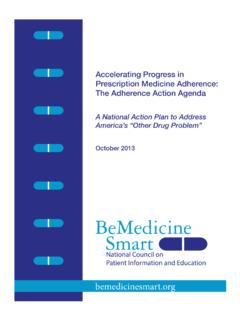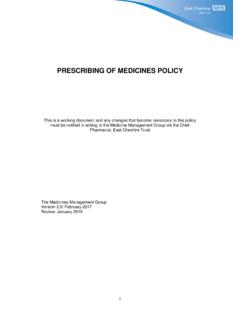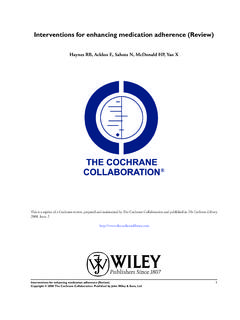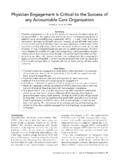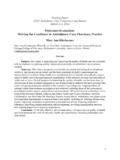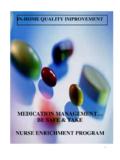Transcription of American Society of Interventional Pain Physicians …
1 Pain Physician 2012; 15:S67-S116 ISSN 1533-3159. ASIPP - Opioid Guidelines 2012. American Society of Interventional Pain Physicians (ASIPP) Guidelines for Responsible Opioid Prescribing in Chronic Non-Cancer Pain: Part 2 - Guidance Laxmaiah Manchikanti, MD1, Salahadin Abdi, MD, PhD2, Sairam Atluri, MD3, Carl C. Balog, MD4, Ramsin M. Benyamin, MD5, Mark V. Boswell, MD, PhD6, Keith R. Brown, PharmD7, Brian M. Bruel, MD8, David A. Bryce, MD9, Patricia A. Burks, LPT10, Allen W. Burton, MD11, Aaron K. Calodney, MD12, David L. Caraway, MD13, Kimberly A. Cash, RT14, Paul J. Christo, MD15, Kim S. Damron, RN16, Sukdeb Datta, MD17, Timothy R. Deer, MD18, Sudhir Diwan, MD19, Ike Eriator, MD20, Frank Falco, MD21, Bert Fellows, MA22, Stephanie Geffert, MLIS23, Christopher G.
2 Gharibo, MD24, Scott E. Glaser, MD25, Jay S. Grider, DO, PhD26, Haroon Hameed, MD27, Mariam Hameed, MD28, Hans Hansen, MD29, Michael E. Harned, MD30, Salim M. Hayek, MD, PhD31, Standiford Helm II, MD32, Joshua A. Hirsch, MD33, Jeffrey W. Janata, PhD34, Adam M. Kaye, PharmD35, Alan D. Kaye, MD, PhD36, David S. Kloth, MD37, Dhanalakshmi Koyyalagunta, MD38, Marion Lee, MD39, Yogesh Malla, MD40, Kavita N. Manchikanti, MD41, Carla D. McManus, RN, BSN42, Vidyasagar Pampati, MSc43, Allan T. Parr, MD44, Ramarao Pasupuleti, MD45, Vikram B. Patel, MD46, Nalini Sehgal, MD47, Sanford M. Silverman, MD48, Vijay Singh, MD49, Howard S. Smith, MD50, Lee T. Snook, MD51, Daneshvari R. Solanki, MD52, Deborah H.
3 Tracy, MD53, Ricardo Vallejo, MD, PhD54, Bradley W. Wargo, DO55. Results: From: American Society Part 2 of the guidelines on responsible opioid prescribing provides the following recommendations for of Interventional Pain initiating and maintaining chronic opioid therapy of 90 days or longer. Physicians 1. A) Comprehensive assessment and documentation is recommended before initiating opioid Complete author therapy, including documentation of comprehensive history, general medical condition, affiliations and disclosures psychosocial history, psychiatric status, and substance use history. (Evidence: good). listed on pages S98-S100. B) Despite limited evidence for reliability and accuracy, screening for opioid use is recommended, as it will identify opioid abusers and reduce opioid abuse.
4 (Evidence: limited). Address Correspondence: ASIPP. C) Prescription monitoring programs must be implemented, as they provide data on patterns of 81 Lakeview Drive prescription usage, reduce prescription drug abuse or doctor shopping. (Evidence: good to fair). Paducah, Kentucky 42003 D) Urine drug testing (UDT) must be implemented from initiation along with subsequent E-mail: adherence monitoring to decrease prescription drug abuse or illicit drug use when patients are in chronic pain management therapy. (Evidence: good). Disclaimer: The authors are solely responsible for 2. A) Establish appropriate physical diagnosis and psychological diagnosis if available prior to the content of this article.
5 Initiating opioid therapy. (Evidence: good). No statement in this article B) Caution must be exercised in ordering various imaging and other evaluations, interpretation should be construed as an and communication with the patient; to avoid increased fear, activity restriction, requests for official position of ASIPP. increased opioids, and maladaptive behaviors. (Evidence: good). Manuscript received: C) Stratify patients into one of the 3 risk categories low, medium, or high risk. 06/22/2012 D) A pain management consultation, may assist non-pain Physicians , if high-dose opioid therapy Accepted for publication: is utilized. (Evidence: fair). 07/02/2012. 3. Essential to establish medical necessity prior to initiation or maintenance of opioid therapy.
6 Free full manuscript: (Evidence: good). 4. Establish treatment goals of opioid therapy with regard to pain relief and improvement in function. com (Evidence: good). 5. A) Long-acting opioids in high doses are recommended only in specific circumstances with severe intractable pain that is not amenable to short-acting or moderate doses of long-acting opioids, as there is no significant difference between long-acting and short-acting opioids for their effectiveness or adverse effects. (Evidence: fair). B) The relative and absolute contraindications to opioid use in chronic non-cancer pain must be evaluated including respiratory instability, acute psychiatric instability, uncontrolled suicide risk, active or history of alcohol or substance abuse, confirmed allergy to opioid agents, Pain Physician: Opioid Special Issue 2012; 15:S67-S116.
7 Coadministration of drugs capable of inducing life-limiting drug interaction, concomitant use of benzodiazepines, active diversion of controlled substances, and concomitant use of heavy doses of central nervous system depressants. (Evidence: fair to limited). 6. A robust agreement which is followed by all parties is essential in initiating and maintaining opioid therapy as such agreements reduce overuse, misuse, abuse, and diversion. (Evidence: fair). 7. A) Once medical necessity is established, opioid therapy may be initiated with low doses and short-acting drugs with appropriate monitoring to provide effective relief and avoid side effects. (Evidence: fair for short-term effectiveness, limited for long-term effectiveness).
8 B) Up to 40 mg of morphine equivalent is considered as low dose, 41 to 90 mg of morphine equivalent as a moderate dose, and greater than 91 mg of morphine equivalence as high dose. (Evidence: fair). C) In reference to long-acting opioids, titration must be carried out with caution and overdose and misuse must be avoided. (Evidence: good). 8. A) Methadone is recommended for use in late stages after failure of other opioid therapy and only by clinicians with specific training in the risks and uses. (Evidence: limited). B) Monitoring recommendation for methadone prescription is that an electrocardiogram should be obtained prior to initiation, at 30 days and yearly thereafter. (Evidence: fair).
9 9. In order to reduce prescription drug abuse and doctor shopping, adherence monitoring by UDT and PMDPs provide evidence that is essential to the identification of those patients who are non-compliant or abusing prescription drugs or illicit drugs. (Evidence: fair). 10. Constipation must be closely monitored and a bowel regimen be initiated as soon as deemed necessary. (Evidence: good). 11. Chronic opioid therapy may be continued, with continuous adherence monitoring, in well-selected populations, in conjunction with or after failure of other modalities of treatments with improvement in physical and functional status and minimal adverse effects. (Evidence: fair). Disclaimer: The guidelines are based on the best available evidence and do not constitute inflexible treatment recommendations.
10 Due to the changing body of evidence, this document is not intended to be a standard of care.. Key words: Chronic pain, persistent pain, non-cancer pain, controlled substances, substance abuse, prescription drug abuse, dependency, opioids, prescription monitoring, drug testing, adherence monitoring, diversion Pain Physician 2012; 15:S67-S116. E vidence-based clinical practice guidelines for responsible opioid prescribing in non-cancer pain are statements developed to improve the quality of care, patient access, treatment outcomes, appropriateness of care, deficiency and effectiveness, is equivalent to kg of opioid medication per 10,000. population or enough to supply every adult American with 5 mg of hydrocodone every 6 hours for 45 days.



